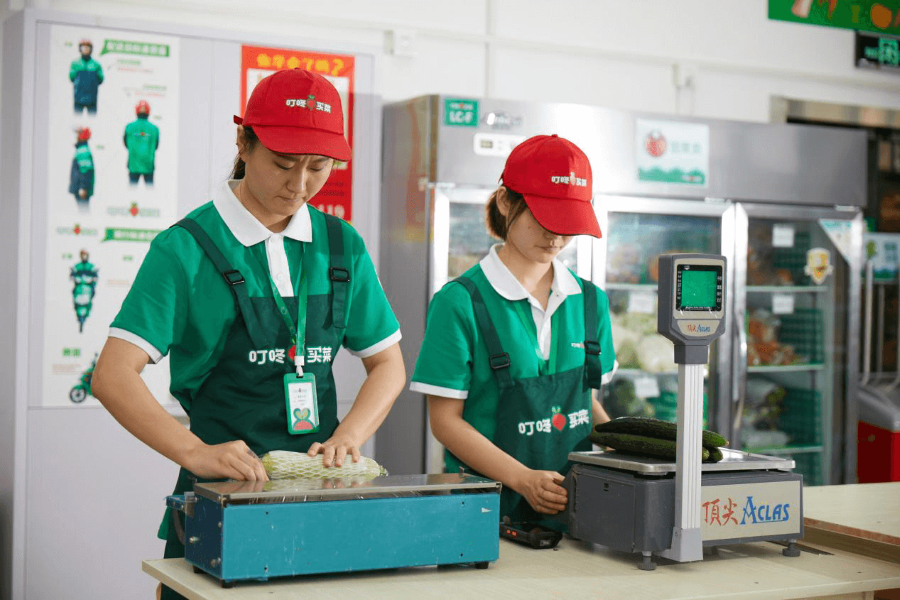Dingdong Slows Down Spending, Dangles Prospect of Profits

Leading online grocer’s new focus on cost controls helped it pare its losses in the fourth quarter
Key Takeaways:
- Dingdong’s revenue growth slowed to 72% in the fourth quarter, down from 111% and 78% in the third and second quarters, respectively
- Leading online grocer also reined in its spending, helping pare its quarterly net loss by 12% as it talked of profitability ‘soon’.
By Doug Young
After years of spending on breakneck growth, leading online grocer Dingdong Cayman Ltd. (DDL.US) finally appears to be slowing down in response to investor demands that it find a way to operate profitably.
That’s the big message in the company’s latest fourth-quarter report, which is peppered with references to profits in the not-too-distant future in comments from founder and CEO Liang Changlin. At the same time, growth in the company’s spending slowed dramatically in the quarter, showing it’s trying to rein costs in pursuit of its ultimate goal of profitability.
Dingdong’s smaller rival, Missfresh (MF.US) is also trying to show investors it’s moving in the same direction, though with a distinctly different focus. Whereas Dingdong looks more focused on being the biggest and pumping up its overall sales volume, Missfresh is trying to convince investors it can thrive by offering higher-margin value-added products and services like ready-made meals and premium private-label products.
So far investors seem to be favoring Dingdong, showing they believe that “bigger is better” in China’s massive grocery market with 1.4 billion consumers. Dingdong’s shares have embarked on a recent rally that has sent them up by 77% from all-time lows in late January. By comparison, Missfresh’s shares are up over the same period but by a far smaller 6%.
In valuation terms, Dingdong has a price-to-book (P/B) ratio of 0.9, nearing the watershed mark of 1 over which investors believe its market value is worth more than its net assets and liabilities. By comparison, Missfresh still trades at a relatively lowly P/B of 0.6. Analysts actually see quite a bit of upside in Dingdong’s stock in the year ahead, which we’ll discuss a bit later.
But first we’ll zoom in on the company’s latest financial report, which is among the first to come out in this year’s China earnings season.
Dingdong’s revenue grew 72% in the final three months of last year to 5.5 billion yuan ($867 million), with nearly all of that coming from product sales. While that growth figure looks strong, it was actually down quite a bit from the 111% growth in the third quarter, though it wasn’t too far off the 78% increase in the second quarter.
But equally notable, the company’s operating costs rose just 48% for the quarter year-on-year to 6.5 billion yuan, far slower than the 117% rise in those costs during the third quarter and 93% in the second. As a result, the company was able to pare its net loss by 12% to 1.1 billion yuan in this year’s final quarter from 1.25 billion yuan a year earlier.
Investors didn’t seem too impressed with the report, perhaps because they’re more used to seeing bigger growth instead of cost control. The stock fell 1.8% in Tuesday trade after the results were announced, and was down another 2.5% after-hours. Still, some might see those declines as more of a pause, as investors pocket some profits following the stock’s recent big gains.
Profits in sight
With those big-picture financials in mind, we’ll move to the comments section of the announcement that looks designed to tell investors that profits may not be too far away.
The company said it is already “fully profitable” in its home base of Shanghai, China’s commercial capital and easily one of the country’s wealthiest cities. From our own China base here in Shanghai, we can comfortably confirm Dingdong’s dominance in the city, with its trademark scooters and their green pouches a regular fixture on streets and in residential compounds throughout the area.
“Shanghai is the first city we entered and has continued innovating and iterating, constructing precedents and experiences for our nationwide operations,” CEO Liang said in remarks accompanying the results. “We have found the path to profitability in this city and expect the whole Yangtze River Delta to be the next, and the whole company will follow suit soon.”
He didn’t provide a more-specific timeline, nor were the company’s recent cost-control measures mentioned in his comments.
Analysts don’t see Dingdong becoming profitable this year, though the six polled by Yahoo Finance see its net loss narrowing in 2022 by about 30% from 2021 levels. At the same time, they see the company’s revenue growing just 50% this year, which again would mark a major slowdown as the market continues to mature and it slows its strategy of chasing growth at any cost.
The reality is that Dingdong is facing competition not only from Missfresh, but some of China’s biggest internet companies led by online-to-offline services giant Meituan (3690.HK) and leading low-cost e-commerce firm Pinduoduo (PDD.US).
But Dingdong and Missfresh are targeting the higher end of the market with their direct sales model that gives them control over their entire supply chain, from the farms where fresh produce is grown to the warehouses where products are stored before being sent to customers. By comparison, Meituan and Pinduoduo use a lower-cost model that delegates most responsibilities to third-party partners, allowing them to offer lower prices to more cost-sensitive customers, but at the cost of sacrificing some quality control.
Dingdong’s recent rally seems to show investors are starting to warm to the company, though we should note the stock at its current levels is still about two-thirds below its $23 IPO price from late last June. But Missfresh’s stock is now down by an even bigger 77% from its IPO price, again showing Dingdong still holds the edge in investors’ eyes.
Analysts are even more bullish on Dingdong – some might say perhaps even a tad too bullish. Of the seven polled by Yahoo Finance in January, four gave the company a “strong buy,” another two rated it a “buy,” and just one rated it “underperform.” But the most eye-popping figure is the average analyst price target, which now stands at $34.19 – nearly five times the stock’s Tuesday close of $7.30 and also well above the $23 IPO price.
To subscribe to Bamboo Works free weekly newsletter, click here






